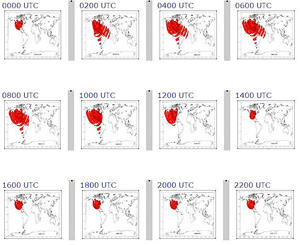
Computer-generated estimates of WWVB signal strength under typical conditions show coverage at two-hour intervals over the course of a day with WWVB operating at 50 kW radiated power. Red indicates areas where signal levels are 100 microvolts per meter or greater. Conversion: U.S. Eastern Daylight Time is UTC minus four hours.
For huge numbers of people in North America who spend their days in schools, offices, stores, factories and public facilities, the time of their lives comes from clocks controlled by a single radio station that few people have ever heard: WWVB in Ft. Collins, Colorado, operated by PML's Time and Frequency Division.
According to the latest estimates, there are at least 50 million radio-controlled clocks in operation (and another few million wristwatches) all receiving accurate time from WWVB's 60 kHz broadcast—and approximately a million new commercial radio-controlled products are sold each year.
WWVB's AM signal, with a wavelength of 5000 meters, propagates over extremely long distances. But even at this very long wavelength signal power decreases with distance from the Colorado transmitter. Coupled with increasing sources of radio frequency interference throughout the country, it is getting more difficult for some radio-controlled timepieces to receive a strong, "clean" signal from WWVB—especially for timepieces used by the half of the U.S. population in the eastern part of the nation, where the weaker WWVB signal far from the Colorado transmitter is more easily drowned out by growing interference.
To address that issue, John Lowe, manager of NIST's radio stations(WWV, WWVH and WWVB), is proceeding on two initiatives simultaneously.
One is to have the U.S. Navy's Space & Naval Warfare Systems Command conduct an analysis of the existing WWVB station and create a report on what it would take to double the power of the station as well as broadcast on two frequencies. "The report should be completed sometime next spring," Lowe says.
The second path involves investigating the feasibility of placing a Phase Modulation (PM) scheme on the broadcast while retaining the existing Amplitude Modulation (AM) scheme of the WWVB signal.
"All the existing devices would continue to work," Lowe emphasizes. But "a new type of receiver could be developed that would take advantage of the PM's greater processing gain. This advantage, coupled with a new type of PM receiving antenna, might increase effective received signal by a factor of more than 100 times, overcoming the vast majority of problems due to interference or weak WWVB signal strength, although the full extent is yet to be determined."
Such upgrades, if fully implemented, coupled with the expansion of radio control beyond watches and clocks into other consumer electronic devices and appliances, "might well revolutionize the clock world," Lowe says—eliminating the need for manual adjustments when Daylight Saving Time begins and ends, and allowing automatic resetting of clocks following a power outage.

